Gibbs energy of complex formation – combining infrared spectroscopy and vibrational theory
IF 2.5
2区 化学
Q3 CHEMISTRY, PHYSICAL
引用次数: 9
Abstract
ABSTRACT Formation and growth of atmospheric aerosols are governed by the Gibbs energy of complex formation (). A number of hydrogen bound bimolecular complexes in the gas phase at room temperature have been detected. In this review, we illustrate how can be determined by combining gas phase infrared spectroscopy and vibrational theory. The XH-stretching (where X is a heavy atom like O) fundamental transition of the hydrogen bond donor molecule in the complex is redshifted and its intensity enhanced upon complexation. This facilitates detection of weak complexes even though the equilibrium is shifted towards the monomers at room temperature. The ratio of the measured and calculated intensity of the vibrational transition is proportional to the complex abundance, which with known monomer pressures gives the equilibrium constant and thus . This approach relies on calculated vibrational transitions in the complexes. An accurate description of the observed bound XH-stretching fundamental transition is challenging due to effects of the low-frequency intermolecular modes. We have developed reduced dimensionality vibrational models within the local mode picture to calculate accurate vibrational intensities. For complexes with an alcohol donor molecule, we find that P, O or S as the acceptor atom of the hydrogen bond results in very similar hydrogen bond strength, whereas N provides a significantly stronger bond.配合物形成的吉布斯能——结合红外光谱和振动理论
大气气溶胶的形成和生长受络合物形成的吉布斯能()的支配。在室温下,已经检测到气相中的一些氢键双分子配合物。在这篇综述中,我们说明了如何结合气相红外光谱和振动理论来确定。配合物中氢键供体分子的xh -拉伸(其中X是像O一样的重原子)基本跃迁发生红移,其强度随着配合而增强。这有利于弱配合物的检测,即使平衡转移到单体在室温下。振动跃迁的测量强度和计算强度之比与复合体丰度成正比,在已知单体压力的情况下,复合体丰度给出了平衡常数。这种方法依赖于计算出的复合物中的振动跃迁。由于低频分子间模式的影响,对观察到的束缚xh拉伸基本跃迁的准确描述是具有挑战性的。我们在局部模态图中开发了降维振动模型来计算精确的振动强度。对于有醇供体分子的配合物,我们发现P、O或S作为氢键的受体原子会产生非常相似的氢键强度,而N则提供明显更强的键。
本文章由计算机程序翻译,如有差异,请以英文原文为准。
求助全文
约1分钟内获得全文
求助全文
来源期刊
CiteScore
14.20
自引率
1.60%
发文量
5
审稿时长
1 months
期刊介绍:
International Reviews in Physical Chemistry publishes review articles describing frontier research areas in physical chemistry. Internationally renowned scientists describe their own research in the wider context of the field. The articles are of interest not only to specialists but also to those wishing to read general and authoritative accounts of recent developments in physical chemistry, chemical physics and theoretical chemistry. The journal appeals to research workers, lecturers and research students alike.

 求助内容:
求助内容: 应助结果提醒方式:
应助结果提醒方式:


